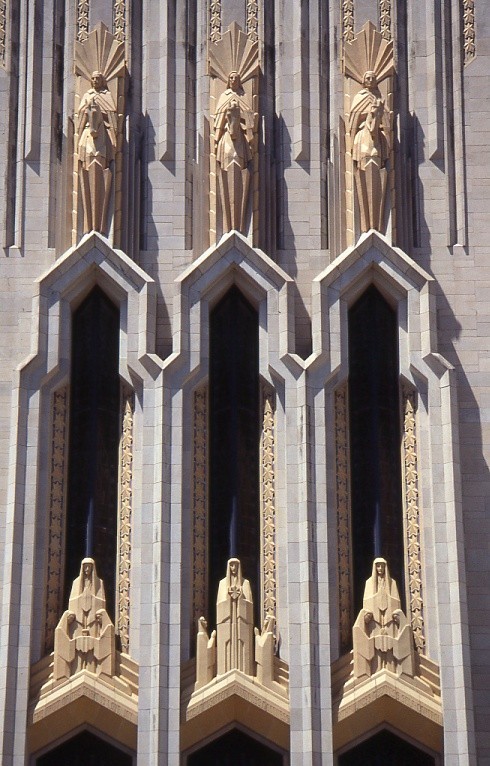The Encyclopedia of Oklahoma History and Culture
BOSTON AVENUE METHODIST EPISCOPAL CHURCH.
Designated a National Historic Landmark for its national architectural significance, the Boston Avenue Methodist Episcopal Church building is located at Thirteenth Street and Boston Avenue in Tulsa, Oklahoma. Constructed in 1924–29, the building is important as an example of Art Deco, a form of Modernism, a style popular in the U.S. in the 1920–40 period but rarely applied to religious buildings. The $1.25 million edifice was designed by a team, including architect Bruce Goff, of the Tulsa architectural firm Rush, Endacott and Rush, and Adah Robinson, chair of the art department in the University of Tulsa. Goff generally receives most of the credit for the exterior and Robinson for the interior. Innovation in plan and decoration were the project's hallmarks.
The original building consisted of a semicircular auditorium, a massive, 225-foot-tall tower, and an education wing. The tower provides physical, visual, and philosophical linkage of two important church functions—shared worship and Christian education/fellowship. Louis Sullivan's plan of the St. Paul's Methodist Church (1914, Cedar Rapids, Iowa) is a similar, earlier, example of the new concept in church plan that established the idea of having Sunday school and fellowship rooms in a formal wing adjacent to a worship center.
The Boston Avenue church also exemplifies the era's trend toward using new materials, in this case steel, which enabled the building of the church's four-story "skyscraper" tower. Also important are the exterior's terra-cotta sculptures, executed by artist Robert Garrison of Denver. These represent important Methodist figures Francis Asbury, William McKendrie, and an Unknown Circuit Rider, as well as the abstract concepts Spiritual Uplift, Brotherly Love, and Human Service. The most evident decorative element is "praying hands," of which approximately one hundred sets appear on the parapet and the four-story tower. Motifs used in window glass and in interior wood carving and mosaic include coreopsis and red-hot poker (tritoma), both native Oklahoma plants.
Hailed by architectural critics around the nation in 1929, Boston Avenue Methodist Episcopal Church continued to be counted one of the most important examples of Bruce Goff's work. In 1989 the Oklahoma chapter of the American Institute of Architects proclaimed it one of the ten most significant buildings in the state. The Boston Avenue Methodist Episcopal Church was placed on the National Register of Historic Places in 1978 (NR 78002270) and was designated a National Historic Landmark in 1999. The name of the congregation housed there is Boston Avenue United Methodist Church.
See Also
ARCHITECTURE, BRUCE ALONZO GOFF, NATIONAL HISTORIC LANDMARKS, NATIONAL REGISTER OF HISTORIC PLACES, ADAH MATILDA ROBINSON, TULSA
Bibliography
Sheldon Cheney, The New World Architecture (1930; New York: AMS Press, 1967).
David G. DeLong, The Architecture of Bruce Goff: Buildings and Projects, 1916–1924 (New York: Garland Publishing, Inc., 1977).
David G. DeLong, Bruce Goff: Toward Absolute Architecture (New York: Architectural History Foundation, 1988).
Jo Beth Harris, More Than a Building: The First Century of the Boston Avenue United Methodist Church (Tulsa, Okla.: Centennial Committee, 1993).
Citation
The following (as per The Chicago Manual of Style, 17th edition) is the preferred citation for articles:
Dianna Everett, “Boston Avenue Methodist Episcopal Church,” The Encyclopedia of Oklahoma History and Culture, https://www.okhistory.org/publications/enc/entry?entry=BO021.
Published January 15, 2010
© Oklahoma Historical Society



